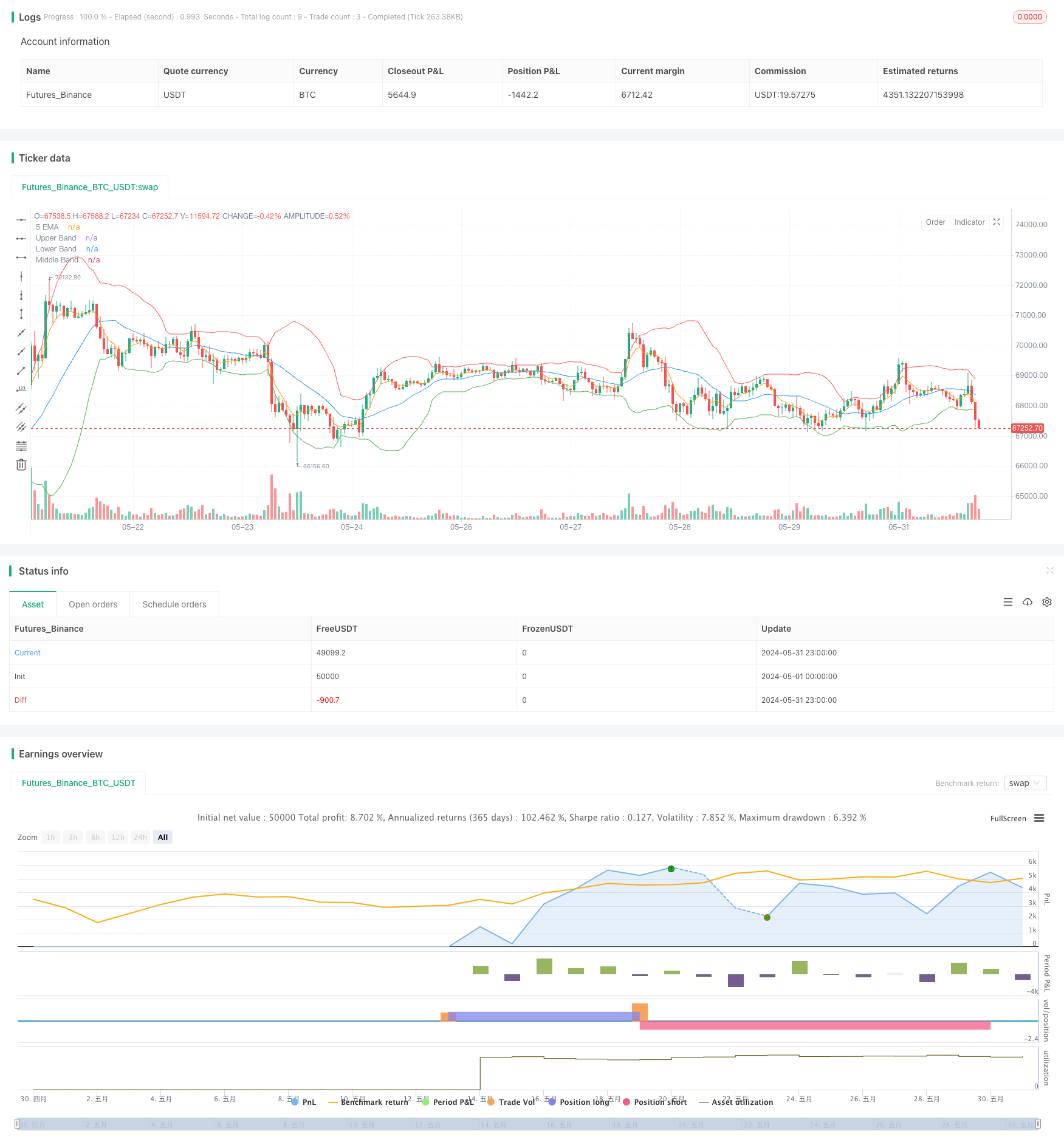
概述
这个策略结合了布林带(Bollinger Bands)和5日指数移动平均线(5-day EMA)来生成交易信号。当价格超出布林带上轨且收盘价低于5日EMA时,开空头仓位;当价格跌破布林带下轨且收盘价高于5日EMA时,开多头仓位。同时,当出现反向信号时,策略会平掉现有仓位并开立新的反向仓位。这个策略旨在捕捉市场的波动性和趋势变化,通过布林带来判断价格的相对高低,并利用EMA作为趋势的滤网,以此来产生交易信号。
策略原理
- 计算布林带的上轨、中轨和下轨。上轨为中轨加上两倍标准差,下轨为中轨减去两倍标准差,中轨为收盘价的简单移动平均线。
- 计算5日EMA作为趋势的参考。
- 当开盘价大于布林带上轨且收盘价小于5日EMA时,开空头仓位。
- 当开盘价小于布林带下轨且收盘价大于5日EMA时,开多头仓位。
- 如果已有空头仓位,当触发多头信号时,平掉空头并开多头仓位。
- 如果已有多头仓位,当触发空头信号时,平掉多头并开空头仓位。
- 如果持有多头仓位,当触发空头平仓信号时,平掉多头仓位。
- 如果持有空头仓位,当触发多头平仓信号时,平掉空头仓位。
策略优势
- 同时利用价格的波动性和趋势特征来产生信号,可以在趋势和震荡行情中把握机会。
- 布林带能够灵活调整参数,适应不同的市场状况和品种特征。
- 5日EMA作为趋势过滤,可以有效降低噪音和频繁交易。
- 及时止损和反向开仓的机制,可以更好地控制风险,并积极把握新的趋势机会。
- 逻辑清晰,容易理解和实现,便于进一步优化。
策略风险
- 参数选择不当可能导致信号失真或者过度交易。需要根据品种和周期进行优化测试。
- 在震荡市可能出现频繁的交易信号,导致过度交易和成本增加。
- 趋势转折点的把握存在滞后,可能错过最佳入场时机。
- 单一技术指标组合可能面临失效的风险,需要与其他信号进行验证。
- 极端行情下可能面临失控的风险,需要严格的风控措施。
策略优化方向
- 对布林带的参数如长度、倍数等进行优化,找到最佳的参数组合。
- 对EMA的周期进行优化测试,选择最佳的趋势周期。
- 加入其他趋势类指标如MACD等作为辅助判断,提高趋势把握的准确性。
- 引入波动率指标如ATR等作为止损和仓位管理的依据,控制单笔风险。
- 对交易的时间段进行限制,避开特定时间的非有效波动。
- 根据行情特征,设置适当的止盈止损策略。
总结
该策略通过布林带和EMA的结合,可以比较有效地捕捉趋势性机会和波动性机会,适用于中长周期的交易策略。但是需要注意参数的优化,仓位的控制以及风险的管理,并且要与其他技术指标和基本面分析相结合,才能更好地发挥策略的效力。策略的表现可能会受到市场状态的影响,需要根据实际情况进行调整和优化。
策略源码
/*backtest
start: 2024-05-01 00:00:00
end: 2024-05-31 23:59:59
period: 1h
basePeriod: 15m
exchanges: [{"eid":"Futures_Binance","currency":"BTC_USDT"}]
*/
//@version=5
strategy("Bollinger Bands and EMA Strategy", overlay=true)
// Define the Bollinger Bands
length = input.int(20, title="BB Length")
src = input(close, title="BB Source")
mult = input.float(2.0, title="BB Multiplier")
basis = ta.sma(src, length)
dev = mult * ta.stdev(src, length)
upper = basis + dev
lower = basis - dev
// Plot Bollinger Bands
plot(upper, "Upper Band", color=color.red)
plot(lower, "Lower Band", color=color.green)
plot(basis, "Middle Band", color=color.blue) // Use plot instead of hline for basis
// Define the 5-period EMA
ema5 = ta.ema(close, 5)
// Plot the 5 EMA
plot(ema5, "5 EMA", color=color.orange)
// Generate signals
var float entry_price = na
var string trade_direction = "none"
if (na(close[1]))
trade_direction := "none"
// Condition for entering a short trade
if (open > upper and close < ema5)
if (trade_direction != "short")
strategy.entry("Short", strategy.short)
entry_price := close
trade_direction := "short"
// Condition for entering a long trade
if (open < lower and close > ema5)
if (trade_direction != "long")
strategy.entry("Long", strategy.long)
entry_price := close
trade_direction := "long"
// Close short trade on a long signal
if (trade_direction == "short" and open < lower and close > ema5)
strategy.close("Short")
strategy.entry("Long", strategy.long)
entry_price := close
trade_direction := "long"
// Close long trade on a short signal
if (trade_direction == "long" and open > upper and close < ema5)
strategy.close("Long")
strategy.entry("Short", strategy.short)
entry_price := close
trade_direction := "short"
// Close trades when opposite signal is generated
if (trade_direction == "long" and open > upper and close < ema5)
strategy.close("Long")
trade_direction := "none"
if (trade_direction == "short" and open < lower and close > ema5)
strategy.close("Short")
trade_direction := "none"
相关推荐